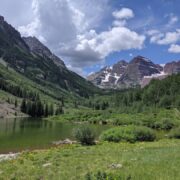
Exploring the Great Outdoors: Hiking and Trail Running Adventures
Hiking and trail running are two outdoor activities that offer numerous benefits for both physical and mental health. Whether you prefer a leisurely hike through the woods or a challenging trail run up a mountain, spending time in nature can have a profound impact on your overall well-being. In this article, we will explore the many benefits of hiking and trail running, discuss essential gear and preparation, highlight some of the best destinations in the United States, provide tips for staying safe and avoiding injuries, and offer advice for beginners and experienced adventurers alike. So grab your hiking boots or running shoes and get ready to hit the trails!
Key Takeaways
- Hiking and trail running provide numerous physical and mental health benefits, including improved cardiovascular health, reduced stress and anxiety, and increased overall fitness.
- Essential gear and preparation for hiking and trail running include proper footwear, hydration, and navigation tools such as maps and compasses.
- The United States offers a variety of top hiking and trail running destinations, including national parks and wilderness areas such as Yosemite and the Grand Canyon.
- To stay safe and avoid common injuries while hiking and trail running, it is important to properly warm up, stay hydrated, and be aware of potential hazards such as wildlife and uneven terrain.
- Beginners can start with easy hiking and trail running trails, such as those found in local parks or nature reserves, and gradually increase difficulty as they gain experience and fitness.
The Benefits of Hiking and Trail Running for Physical and Mental Health
Hiking and trail running are excellent forms of exercise that offer a wide range of physical benefits. Both activities engage multiple muscle groups, improve cardiovascular fitness, and help to build strength and endurance. Hiking is a low-impact activity that is suitable for people of all fitness levels, while trail running provides a more intense workout that can help to improve speed and agility.
In addition to the physical benefits, hiking and trail running also have a positive impact on mental health. Spending time in nature has been shown to reduce stress levels, improve mood, and increase feelings of happiness and well-being. The combination of fresh air, natural scenery, and physical activity can help to clear the mind, reduce anxiety, and promote relaxation. Many people find that hiking or trail running provides a sense of escape from the pressures of everyday life and allows them to connect with nature on a deeper level.
Essential Gear and Preparation for Hiking and Trail Running
Before heading out on a hike or trail run, it is important to have the right gear and be properly prepared. For hiking, essential gear includes sturdy hiking boots or shoes, comfortable clothing suitable for the weather conditions, a backpack with water and snacks, a map or GPS device, a first aid kit, and sunscreen. It is also important to check the weather forecast and trail conditions before setting out, and to let someone know your plans and expected return time.
For trail running, the gear requirements are similar, but with a few additional considerations. In addition to proper running shoes, it is important to wear moisture-wicking clothing to help regulate body temperature and prevent chafing. A hydration pack or handheld water bottle is essential for staying hydrated during longer runs, and a headlamp or other source of light may be necessary if running in low-light conditions. It is also important to carry a cell phone for emergencies and to be aware of any wildlife or potential hazards on the trail.
Top Hiking and Trail Running Destinations in the United States
| Destination | State | Distance (miles) | Elevation Gain (feet) | Difficulty Level |
|---|---|---|---|---|
| Grand Canyon | Arizona | 24 | 4,380 | Difficult |
| Yosemite National Park | California | 8.2 | 3,200 | Moderate |
| Mount Rainier | Washington | 9.4 | 4,400 | Difficult |
| Yellowstone National Park | Wyoming | 7.2 | 1,100 | Moderate |
| Mount Whitney | California | 22 | 6,100 | Difficult |
The United States is home to some of the most breathtaking hiking and trail running destinations in the world. From the rugged mountains of the West to the lush forests of the East, there is something for everyone. Some of the top destinations include:
– Yosemite National Park: Located in California’s Sierra Nevada mountains, Yosemite offers a wide range of hiking and trail running options, from easy walks to challenging climbs. Highlights include the iconic Half Dome hike and the Mist Trail to Vernal Falls.
– Rocky Mountain National Park: Situated in Colorado’s Front Range, Rocky Mountain National Park is a paradise for outdoor enthusiasts. The park offers a variety of trails ranging from easy strolls to strenuous hikes, with stunning views of snow-capped peaks, alpine lakes, and abundant wildlife.
– Appalachian Trail: Stretching over 2,000 miles from Georgia to Maine, the Appalachian Trail is a bucket-list destination for hikers and trail runners. The trail passes through 14 states and offers a diverse range of landscapes, from rolling hills to rugged mountains.
– Grand Canyon National Park: One of the Seven Natural Wonders of the World, the Grand Canyon is a must-visit destination for outdoor enthusiasts. The park offers a variety of hiking trails, ranging from easy rim walks to challenging descents into the canyon.
How to Stay Safe and Avoid Common Injuries While Hiking and Trail Running
While hiking and trail running are generally safe activities, it is important to take precautions to avoid common injuries and stay safe on the trails. Some common injuries that can occur include sprained ankles, knee pain, blisters, and dehydration.
To stay safe while hiking or trail running, it is important to wear appropriate footwear that provides good ankle support and traction. It is also important to warm up before starting your hike or run, and to stretch afterwards to prevent muscle soreness. It is also important to stay hydrated by drinking plenty of water before, during, and after your hike or run.
To avoid blisters, it is important to wear moisture-wicking socks and properly fitting shoes. If you feel a hot spot developing, stop and apply moleskin or a blister bandage to prevent further irritation. It is also important to listen to your body and take breaks as needed. If you start to feel pain or discomfort, it is important to stop and rest.
The Best Hiking and Trail Running Trails for Beginners
For those new to hiking and trail running, there are many trails that are perfect for beginners. These trails offer a combination of scenic beauty and manageable terrain, making them ideal for those looking to get started in these activities.
One such trail is the Angel’s Landing Trail in Zion National Park, Utah. This trail offers stunning views of the park’s red rock formations and can be completed in a few hours. While it does involve some steep sections and narrow ledges, it is suitable for beginners with a moderate level of fitness.
Another great trail for beginners is the Skyline Trail in Mount Rainier National Park, Washington. This trail offers panoramic views of the surrounding mountains and glaciers, and can be completed in a day. The trail is well-maintained and offers a gradual ascent, making it suitable for beginners.
How to Plan and Execute a Successful Backpacking Trip
For those looking to take their hiking or trail running to the next level, backpacking offers a unique and rewarding experience. Planning and executing a successful backpacking trip requires careful preparation and attention to detail.
The first step in planning a backpacking trip is to choose a destination and research the trail. Consider factors such as distance, elevation gain, terrain, and weather conditions. It is also important to obtain any necessary permits or reservations.
Next, create a packing list and gather all the necessary gear. This includes a backpack, tent, sleeping bag, cooking equipment, food, water purification system, clothing suitable for the weather conditions, and a first aid kit. It is important to pack light but also be prepared for unexpected changes in weather or trail conditions.
Once on the trail, it is important to pace yourself and listen to your body. Take breaks as needed and stay hydrated and fueled with regular snacks and meals. It is also important to practice Leave No Trace principles by packing out all trash, minimizing campfire impacts, and respecting wildlife and other hikers.
The Benefits of Hiking and Trail Running in National Parks and Wilderness Areas
Hiking and trail running in national parks and wilderness areas offer unique benefits that cannot be found elsewhere. These protected areas provide opportunities for solitude, connection with nature, and a sense of awe and wonder.
National parks are often home to some of the most iconic landscapes in the country, such as the Grand Canyon, Yellowstone, and Yosemite. These parks offer well-maintained trails that allow visitors to explore the natural beauty of the area while also providing educational opportunities through interpretive signs and ranger-led programs.
Wilderness areas, on the other hand, offer a more rugged and remote experience. These areas are typically less developed and offer a greater sense of solitude and immersion in nature. Hiking and trail running in wilderness areas can be more challenging, but the rewards are often greater in terms of pristine landscapes and a deeper connection with the natural world.
The Best Hiking and Trail Running Trails for Experienced Adventurers
For experienced adventurers looking for a challenge, there are many trails that offer a more demanding experience. These trails often involve steep ascents, rugged terrain, and longer distances, but the rewards are well worth the effort.
One such trail is the Pacific Crest Trail (PCT), which stretches over 2,600 miles from Mexico to Canada. This iconic trail offers stunning views of the Sierra Nevada and Cascade mountain ranges, as well as a diverse range of ecosystems and landscapes. Completing the entire PCT is a feat that few achieve, but even hiking or trail running a section of the trail can be a life-changing experience.
Another challenging trail is the Appalachian Trail (AT), which stretches over 2,000 miles from Georgia to Maine. The AT offers a variety of terrain, from rocky ridges to dense forests, and provides hikers and trail runners with a true wilderness experience. Completing the entire AT is a significant accomplishment, but even hiking or trail running a section of the trail can be an adventure of a lifetime.
The Importance of Leave No Trace Principles While Hiking and Trail Running
Leave No Trace principles are guidelines that promote responsible outdoor recreation and help to minimize our impact on the environment. These principles are especially important when hiking and trail running, as they help to preserve the natural beauty of our trails and ensure that future generations can enjoy them as well.
The seven Leave No Trace principles include:
1. Plan ahead and prepare: Research your destination, check weather conditions, and bring the necessary gear and supplies.
2. Travel and camp on durable surfaces: Stick to established trails and campsites to minimize damage to vegetation and soil.
3. Dispose of waste properly: Pack out all trash and human waste, and leave no trace of your visit.
4. Leave what you find: Do not disturb or remove plants, rocks, or artifacts from the trail.
5. Minimize campfire impacts: Use established fire rings or stoves, and be mindful of fire restrictions and regulations.
6. Respect wildlife: Observe animals from a distance and do not feed or approach them.
7. Be considerate of other visitors: Yield to other hikers and trail runners, keep noise levels down, and respect the solitude of others.
By practicing these principles, we can help to protect our trails and ensure that they remain pristine for future generations to enjoy.
How to Incorporate Hiking and Trail Running into Your Fitness Routine
Incorporating hiking and trail running into your fitness routine is a great way to add variety and challenge to your workouts. Here are some tips for getting started:
– Start slow: If you are new to hiking or trail running, start with shorter distances or easier trails and gradually increase the intensity as your fitness improves.
– Mix it up: Vary your routes and terrain to keep things interesting. Try different trails, elevations, and distances to challenge yourself and prevent boredom.
– Set goals: Whether it’s completing a certain distance or reaching a specific peak, setting goals can help to keep you motivated and focused on your progress.
– Join a group or find a buddy: Hiking or trail running with others can provide motivation, support, and safety. Look for local hiking or running groups in your area or ask a friend to join you.
– Listen to your body: Pay attention to how you feel during and after your hikes or runs. If something doesn’t feel right, take a break or seek medical advice.
Hiking and trail running offer a wide range of physical and mental health benefits, from improved fitness and strength to reduced stress and increased happiness. By incorporating these activities into your fitness routine, you can enjoy the beauty of nature while also improving your overall well-being. Whether you are a beginner or an experienced adventurer, there are trails and destinations for everyone to explore. So lace up your hiking boots or running shoes, grab your gear, and hit the trails. The great outdoors is waiting for you!
FAQs
What is hiking?
Hiking is a recreational activity that involves walking on trails or paths in natural environments, such as forests, mountains, or parks.
What is trail running?
Trail running is a type of running that takes place on trails or unpaved paths, often in natural environments.
What are the benefits of hiking and trail running?
Hiking and trail running are great ways to improve physical fitness, reduce stress, and connect with nature. They can also provide opportunities for socializing and exploring new places.
What equipment do I need for hiking and trail running?
For hiking, you will need sturdy hiking boots or shoes, appropriate clothing for the weather, a backpack, and water. For trail running, you will need trail running shoes, comfortable clothing, and water.
What are some popular hiking and trail running destinations?
There are many popular hiking and trail running destinations around the world, including national parks such as Yosemite and Zion in the United States, the Swiss Alps in Europe, and the Inca Trail in Peru.
What should I do to prepare for a hiking or trail running adventure?
To prepare for a hiking or trail running adventure, you should start by building up your endurance and strength through regular exercise. You should also research the trail or route you plan to take, bring appropriate gear and supplies, and let someone know where you will be going and when you plan to return.













